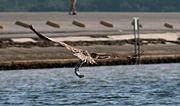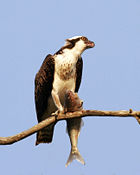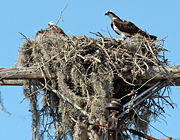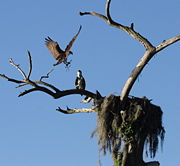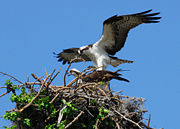Osprey
2008/9 Schools Wikipedia Selection. Related subjects: Birds
| Osprey | ||||||||||||||
|---|---|---|---|---|---|---|---|---|---|---|---|---|---|---|
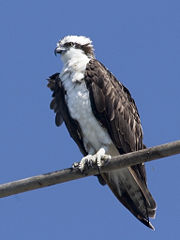 North American subspecies
|
||||||||||||||
| Conservation status | ||||||||||||||
| Scientific classification | ||||||||||||||
|
||||||||||||||
| Binomial name | ||||||||||||||
| Pandion haliaetus (Linnaeus, 1758) |
The Osprey (Pandion haliaetus), also known colloquially as seahawk, fish hawk or fish eagle, is a diurnal, fish-eating bird of prey. It is a large raptor, reaching 60 centimetres (24 in) in length with a 1.8 metre (6 ft) wingspan. It is brown on the upperparts and predominantly whitish on the head and underparts, with a brownish eye patch and wings.
The Osprey tolerates a wide variety of habitats, nesting in any location near a body of water providing an adequate food supply. It is found on all continents except Antarctica although in South America it occurs only as a non-breeding migrant.
As its other common names suggest, the Osprey's diet consists almost exclusively of fish. It has evolved specialised physical characteristics and exhibits some unique behaviours to assist in hunting and catching prey. As a result of these unique characteristics, it has been given its own taxonomic genus, Pandion and family, Pandionidae. Four subspecies are usually recognised. Despite its propensity to nest near water, the Osprey is not a sea-eagle.
Taxonomy
The Osprey was one of the many species described by Carolus Linnaeus in his 18th century work, Systema Naturae, and named as Falco haliaeetus. The genus Pandion was described by the French zoologist Marie Jules César Savigny in 1809.
The Osprey differs in several respects from other diurnal birds of prey. Its toes are of equal length, its tarsi are reticulated, and its talons are rounded, rather than grooved. The Osprey is the only raptor whose outer toe is reversible, allowing it to grasp its prey with two toes in front and two behind. It has always presented something of a riddle to taxonomists, but here it is treated as the sole member of the family Pandionidae, and the family listed in its traditional place as part of the order Falconiformes. Other schemes place it alongside the hawks and eagles in the family Accipitridae—which itself can be regarded as making up the bulk of the order Accipitriformes or else be lumped with the Falconidae into Falconiformes. The Sibley-Ahlquist taxonomy has placed it together with the other diurnal raptors in a greatly enlarged Ciconiiformes, but this results in an unnatural paraphyletic classification.
Classification
The Osprey is unusual insofar as it is a single species that occurs nearly worldwide. Even the few subspecies are not unequivocally separable. There are four generally recognised subspecies, although differences are small, and ITIS only lists the first two.
- P. h. haliaetus (Linnaeus, 1758), Eurasia.
- P. h. carolinensis ( Gmelin, 1788), North America. This form is larger, darker bodied and has a paler breast than nominate haliaetus.
- P. h. ridgwayi ( Maynard, 1887), Caribbean islands. This form has a very pale head and breast compared with nominate haliaetus, with only a weak eye mask. It is non-migratory. Its scientific name commemorates American ornithologist Robert Ridgway.
- P. h. cristatus ( Vieillot, 1816), coastline and some large rivers of Australia and Tasmania. The smallest subspecies, also non-migratory.
Etymology
The genus name Pandion is after the mythical Greek king Pandion of Athens and grandfather of Theseus, who was transformed into an eagle. The specific epithet haliaetus is derived from the Greek αλιάετος "sea-eagle/osprey".
The origins of osprey are obscure; the word itself was first recorded around 1460, derived via the Anglo-french ospriet and the Medieval Latin avis prede "bird of prey," from the Latin avis praedæ though the Oxford English Dictionary notes a connection with the Latin ossifraga or "bone breaker" of Pliny the Elder. However, this term referred to the Lammergeier.
Description
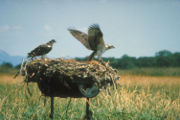
The Osprey is 1.4–2 kilograms (3.0–4.4 lb) in weight and 52–60 centimetres (20–24 in) long with a 150–180 centimetres (5–6 ft) wingspan. The upperparts are a deep, glossy brown, while the breast is white and sometimes streaked with brown, and the underparts are pure white. The head is white with a dark mask across the eyes, reaching to the sides of the neck. The irises of the eyes are golden to brown, and the transparent nictitating membrane is pale blue. The bill is black, with a blue cere, and the feet are white with black talons. A short tail and long, narrow wings with four long, finger-like feathers, and a shorter fifth, give it a very distinctive appearance.
The sexes appear fairly similar, but the adult male can be distinguished from the female by its slimmer body and narrower wings. The breast band of the male is also weaker than that of the female, or is non-existent, and the underwing coverts of the male are more uniformly pale. It is straightforward to determine the sex in a breeding pair, but harder with individual birds.
Juvenile Osprey may be identified by buff fringes to the plumage of the upperparts, a buff tone to the underparts, and streaked feathers on the head. During spring, barring on the underwings and flight feathers is a better indicator of a young bird, due to wear on the upperparts.
In flight, the Osprey has arched wings and drooping "hands", giving it a gull-like appearance. The call is a series of sharp whistles, described as cheep, cheep or yewk, yewk. Near the nest, the call is a frenzied cheereek! Osprey call
Distribution and habitat
The Osprey has a worldwide distribution and is found in temperate and tropical regions of all continents except Antarctica. In North America it breeds from Alaska and Newfoundland south to the Gulf Coast and Florida, wintering further south from the southern United States through to Argentina. It is found in summer throughout Europe north into Scandinavia and Scotland, though not Iceland, and winters in North Africa. In Australia it is mainly sedentary and found patchily around the coastline, though it is a non-breeding visitor to eastern Victoria and Tasmania. There is a 1000 km gap, corresponding with the coast of the Nullarbor Plain, between its westernmost breeding site in South Australia and the nearest breeding sites to the west in Western Australia. In the islands of the Pacific it is found in the Bismarck Islands, Solomon Islands and New Caledonia, and fossil remains of adults and juveniles have been found in Tonga, where it probably was wiped out by arriving humans. It is possible it may once have ranged across Vanuatu and Fiji as well. It is an uncommon to fairly common winter visitor to all parts of South Asia, and Southeast Asia from Myanmar through to Indochina and southern China, Indonesia, Malaysia and the Philippines.
Behaviour
Diet
Fish comprise 99 percent of the Osprey's diet. It typically takes fish weighing 150–300 grammes (5–10 oz) and about 25–35 centimetres (10–14 in) in length, but the weight can range from 50 to 2000 grammes (2–68 oz).
Prey is first sighted when the Osprey is 10–40 metres (32–130 ft) above the water, after which the bird hovers momentarily then plunges feet first into the water. It is able to dive to a depth of one metre (3.3 ft). The angle of entry into the water varies with the nature of the prey; steeper, slower dives are used when pursuing deeper, slow-moving fish, while long, quick dives are used for faster surface fish. After catching the fish considerable effort is needed to get airborne again. As it rises back into flight the fish is turned head-forward to reduce drag.
The Osprey is particularly well adapted to this diet, with reversible outer toes, sharp spicules on the underside of the toes, closable nostrils to keep out water during dives, and backwards-facing scales on the talons which act as barbs to help hold its catch.
Rarely, the Osprey may prey on other wetland animals, such as aquatic rodents, salamanders, other birds, and small reptiles.
Reproduction
The Osprey breeds by freshwater lakes, and sometimes on coastal brackish waters. Rocky outcrops just offshore are used in Rottnest Island off the coast of Western Australia, where there are 14 or so similar nesting sites of which five to seven are used in any one year. Many are renovated each season, and some have been used for 70 years. The nest is a large heap of sticks, driftwood and seaweed built in forks of trees, rocky outcrops, telephone poles, artificial platforms or offshore islets. Generally Ospreys reach sexual maturity and begin breeding around the age of three to four years, though in some regions with high Osprey densities, such as Chesapeake Bay in the U.S., they may not start breeding until five to seven years old, and there may be a shortage of suitable tall structures. If there are no nesting sites available, young Ospreys may be forced to delay breeding. To ease this problem, posts may be erected to provide more sites suitable for nest building.
Ospreys usually mate for life. Rarely, polyandry has been recorded. The breeding season varies according to latitude; spring (September-October) in southern Australia, April to July in northern Australia and winter (June-August) in southern Queensland. In spring the pair begins a five-month period of partnership to raise their young. The female lays two to four eggs within a month, and relies on the size of the nest to conserve heat. The eggs are whitish with bold splotches of reddish-brown and are about 6.2 x 4.5 centimetres (2.4 x 1.8 in) and weigh about 65 grammes (2.4 oz). The eggs are incubated for about 5 weeks to hatching.
The newly hatched chicks weigh only 50–60 grammes (2 oz), but fledge in 8-10 weeks. A study on Kangaroo Island, South Australia, had an average time between hatching and fledging of 69 days. The same study found an average of 0.66 young fledged per year per occupied territory, and 0.92 young fledged per year per active nest. Some 22% of surviving young either remained on the island, or returned at maturity to join the breeding population. When food is scarce, the first chicks to hatch are most likely to survive. The typical lifespan is 20–25 years. In North America Bubo owls and Bald Eagles (and possibly other eagles of comparable size) are the only major predators of both nests and sub adults.
Migration
European breeders winter in Africa. American and Canadian breeders winter in South America, although some stay in the southernmost U.S. states such as Florida and California. Australasian Ospreys tend not to migrate.
Studies of Swedish Ospreys showed that females tend to migrate to Africa earlier than the males. More stopovers are made during their autumn migration. The variation of timing and duration in autumn was more variable than in spring. Although migrating predominantly in the day, they sometimes fly in the dark hours particularly in crossings over water and cover on average 260-280 km/day with a maximum of 431 km/day.
Status
The Osprey has a large range, covering 9,670,000 km² (3.7 million square miles) in just Africa and the Americas, and has a large global population estimated at 460,000 individuals. Although global population trends have not been quantified, the species is not believed to approach the thresholds for the population decline criterion of the IUCN Red List (i.e., declining more than 30% in ten years or three generations), and for these reasons, the species is evaluated as Least Concern. There is evidence for regional decline in South Australia where former territories at locations in the Spencer Gulf and along the lower Murray River have been vacant for decades.
In the late 19th and early 20th centuries, the main threats to Osprey populations were egg collectors and hunting of the adults along with other birds of prey, but Osprey populations declined drastically in many areas in the 1950s and 1960s; this appeared to be in part due to the toxic effects of insecticides such as DDT on reproduction. The pesticide interfered with the bird's calcium metabolism which resulted in thin-shelled, easily broken or infertile eggs. Possibly because of the banning of DDT in many countries in the early 1970s, together with reduced persecution, the Osprey, as well as other affected bird of prey species, have made significant recoveries. In South Australia, nesting sites on the Eyre Peninsula and Kangaroo Island are vulnerable to unmanaged coastal recreation and encroaching urban development.
Cultural depictions
Nisos, a king of Megara in Greek mythology, became a sea eagle or Osprey, to attack his daughter after she fell in love with Minos, king of Crete. The Roman writer Pliny the Elder reported that parent Ospreys made their young fly up to the sun as a test, and dispatch any that failed. Another odd legend regarding this fish-eating bird of prey, derived from the writings of Albertus Magnus and recorded in Holinshed's Chronicles, was that it had one webbed foot and one taloned foot. There was a medieval belief that fish were so mesmerised by the Osprey that they turned belly-up in surrender, and this is referenced by Shakespeare in Act 4 Scene 5 of Coriolanus:
I think he'll be to Rome
As is the osprey to the fish, who takes it
By sovereignty of nature.
The Irish poet William Butler Yeats used a grey wandering Osprey as a representation of sorrow in The Wanderings of Oisin and Other Poems (1889) The Osprey is depicted as a white eagle in heraldry, and more recently has become a symbol of positive responses to nature, and as such has been featured on more than 50 postage stamps.


